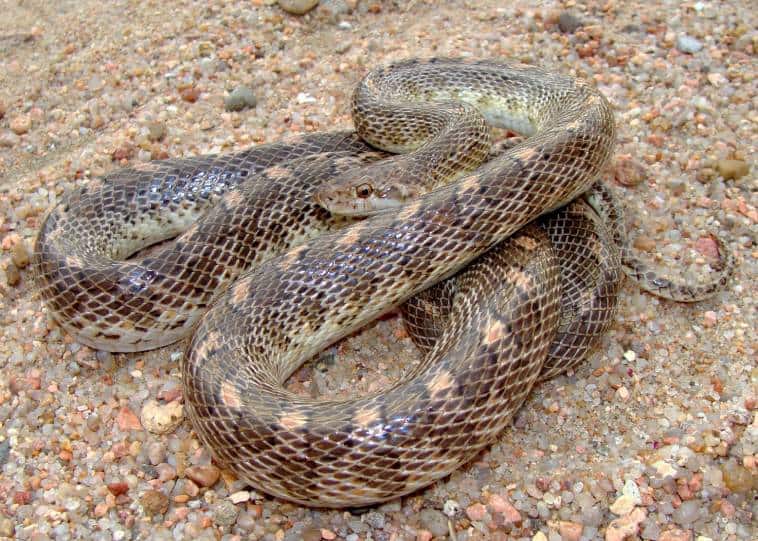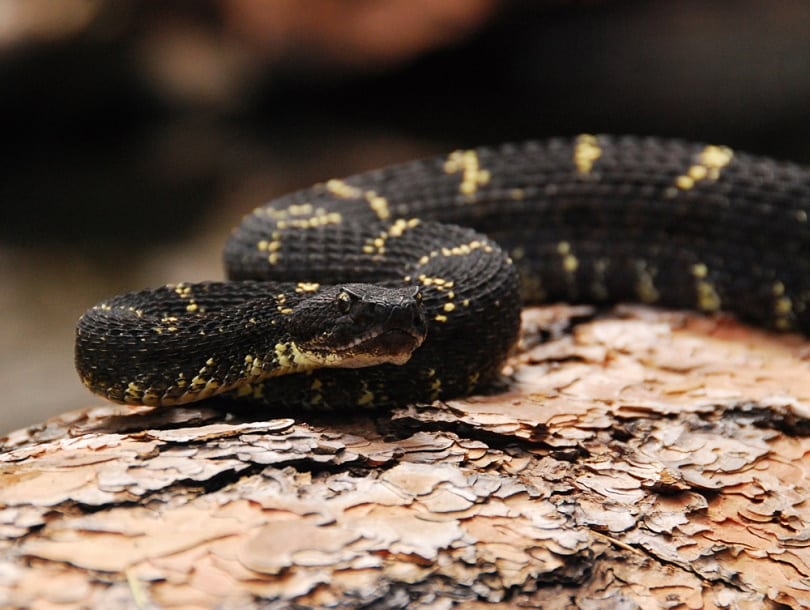Snakes are a common creature both in the real world and in folklore. There are more than 3,000 venomous and non-venomous snakes across the globe. But, what snakes can we go out and see in real life? More than 40 snakes called the various ecosystems of Arizona their homes. Here are ten snakes that you might see in Arizona.

The 10 Snakes Found in Arizona
The 5 Venomous Snakes Found in Arizona
1. Arizona Ridge-Nosed Rattlesnake
| Species: | C. w. willardi |
| Longevity: | 10 – 25 years |
| Good to own as a pet?: | No |
| Legal to own?: | No |
| Adult size: | Up to 26 inches |
| Diet: | Carnivorous |
The Arizona Ridge-Nosed Rattlesnake (Crotalus willardi willardi) is Arizona’s official state reptile! However, these shy and reclusive rattlesnakes are relatively small and prefer to live high in the mountains of Arizona, making human encounters rare and bites even rarer. Due to the lack of recorded medical evidence, the exact methods by which the Arizona Ridge-Nosed Rattlesnake’s venom kills its prey remain mysterious. However, there are no documented deaths from the venom of an Arizona Ridge-Nosed Rattlesnake. One of the few recorded bites, which included both a subject knowledgeable in the study of snakes and photographic evidence of the snake, resulted in just swelling and discomfort; when treated with standard antivenin doses, the subject recovered in just three days.
2. Sonoran Coral Snake
| Species: | M. euryxanthus |
| Longevity: | Up to 10 years |
| Good to own as a pet?: | No |
| Legal to own?: | No |
| Adult size: | 18 – 20 inches |
| Diet: | Small lizards, other small snakes |
The Sonoran Coral Snake, also known as the Arizona Coral Snake or the Western Coral Snake, is another reclusive snake known for its vibrant red, black, and yellow stripes. They come armed with a potent venom that attacks the nervous system and can kill a human within hours of a bite. There were no recorded deaths from coral snake bites from 1967, when an antivenin was produced, until 2006 when an untreated patient died… but don’t stop worrying just yet; the antivenin hasn’t been commercially produced since 2003. All remaining vials expired in 2008. So, keep an eye on the ground and remember: red touches yellow, kills a fellow.
3. Grand Canyon Rattlesnake
| Species: | C. o. abyssus |
| Longevity: | 10 – 25 years |
| Good to own as a pet?: | No |
| Legal to own?: | No |
| Adult size: | 16 – 54 inches |
| Diet: | Carnivorous |
True to its name, the Grand Canyon Rattlesnake can only be found in Arizona and Utah. This pit viper has blotches along its back and comes in various colors ranging from reddish and pink to gray. Though it’s only found in Arizona and Utah, it can be found in several habitats within these areas, including forests, cliff slopes, grasslands, and, of course, around the rims and floor of the Grand Canyon.
4. Hopi Rattlesnake
| Species: | C. v. nuntius |
| Longevity: | 10 – 13 years |
| Good to own as a pet?: | No |
| Legal to own?: | No |
| Adult size: | 15 – 24 inches |
| Diet: | Small mammals, birds, reptiles, and amphibians |
The Crotalus viridis nuntius, also known as the Hopi Rattlesnake, is named for the Native American Hopi tribe that inhabits the northeastern part of Arizona, where these snakes are found. Like other rattlesnakes, the Hopi Rattlesnake has a keratin rattle at the end of its tail, and each time the snake sheds its skin, a new segment is added to the rattle. However, the Hopi rattlesnake’s rattle is exceptionally brittle and breaks off much easier than the average rattlesnake. Thus, the rattle cannot be used to estimate the snake’s age.
5. Arizona Black Rattlesnake
| Species: | C. cerberus |
| Longevity: | 10 – 25 years |
| Good to own as a pet?: | No |
| Legal to own?: | No |
| Adult size: | 31 – 48 inches |
| Diet: | Amphibians, reptiles, birds and their eggs |
The Arizona Black Rattlesnake, or Crotalus cerberus, is found in the Hualapai Mountains and Cottonwood Cliffs in northwest Arizona. Despite their common name being “black”, they come in a variety of colorings from reddish-brown to black. They go through a color change as they get older, becoming darker-colored and less patterned as they age. Some adults can even change their coloring quickly, much like a chameleon!

The 5 Non-Venomous Snakes Found in Arizona
6. Glossy Snake

| Species: | A. elegans |
| Longevity: | Unknown |
| Good to own as a pet?: | No |
| Legal to own?: | No |
| Adult size: | 30 – 70 inches |
| Diet: | Other reptiles, small mammals, and small birds |
You can’t have a list of Arizona’s snakes without the Glossy Snake. The “A.” in the species name stands for Arizona! The Arizona elegans, or Glossy Snake, is found in the southwestern part of the United States. First noted by Robert Kennicott in letters to his mentor Spencer Baird in 1859, the Glossy Snake has nine recognized subspecies. They are named for their smooth and glossy scales in tan, brown, and gray shades. The color of the soil in their native habitat often influences the coloration of their scales!
7. Red Coachwhip
| Species: | M. f. piceus |
| Longevity: | 13 – 20 years |
| Good to own as a pet?: | No |
| Legal to own?: | No |
| Adult size: | 36 – 72 inches |
| Diet: | Lizards, other snakes, birds and eggs, insects |
Red Coachwhips are affectionately referred to as “Red Racers.” They are fast as the name would imply. Traveling at speeds up to four miles per hour, these snakes are non-venomous foragers who seek out and hunt lizards, other snakes, insects, and birds. While they have been observed consuming rodents and amphibians, scientists note that this is rare because they prefer to eat lizards.
8. Arizona Mountain Kingsnake
| Species: | L. pyromelana |
| Longevity: | 10 – 15 years |
| Good to own as a pet?: | No |
| Legal to own?: | No |
| Adult size: | 18 – 44 inches |
| Diet: | Lizards, other snakes, rodents, eggs |
The Arizona Mountain Kingsnake or Lampropeltis pyromelana may look like a coral snake at first glance, but coloring is one of its defense mechanisms! Kingsnakes get their name for their propensity to devour other snakes, and the Arizona Mountain Kingsnake can be found feasting upon rattlesnakes, copperheads, and even the coral snakes they imitate! They make their homes in piles of rocks and rarely venture far from their chosen rock-pile. They even regulate their body temperatures by moving up or down in the pile rather than basking in the sun like other snakes.
9. Arizona Rosy Boa
| Species: | L. t. arizonae |
| Longevity: | 15 – 20 years in the wild, 30+ in captivity |
| Good to own as a pet?: | Yes |
| Legal to own?: | Yes |
| Adult size: | 17 – 34 inches |
| Diet: | Small mammals, occasionally lizards and amphibians |
The Arizona Rosy Boa is one of the snakes that pretty much anyone can own without a permit! Rosy boas make excellent pets because of their small size and docile nature. Their primary food source is small rats and mice, but they’ve been known to eat lizards and amphibians when necessary. There was a brief attempt in 1993 to move the Rosy boa to a different genus because they share some characteristics with the Rubber boa. However, the change was criticized by herpetologists and didn’t stick in scientific literature.
10. Sonoran Gopher Snake
| Species: | P. c. affinis |
| Longevity: | 10 – 15 years, 30 years in captivity |
| Good to own as a pet?: | Yes |
| Legal to own?: | Yes |
| Adult size: | 48 – 72 in |
| Diet: | Small rodents |
Clocking in at over 4 feet long, Sonoran Gopher Snakes may look intimidating, but these constrictors are gentle giants that make great beginner pets for aspiring snake owners! While they usually live about fifteen years in the wild, they can live 30 or more years in captivity! At first, they’re bluffers and may hiss and posture, but they become quite docile once they realize that you mean them no harm.

Conclusion
The world of snakes is no less varied than the world of dogs and cats. The varied geography and diverse selection of small animals for the snakes to hunt makes Arizona an excellent destination for snake sightings. From the massive, gentle Sonoran Gopher Snake to the tiny, deadly Sonoran Coral Snake, there’s no shortage of stunning serpents out there for you to learn about!
Featured Image Credit: jokerbethyname, Shutterstock
